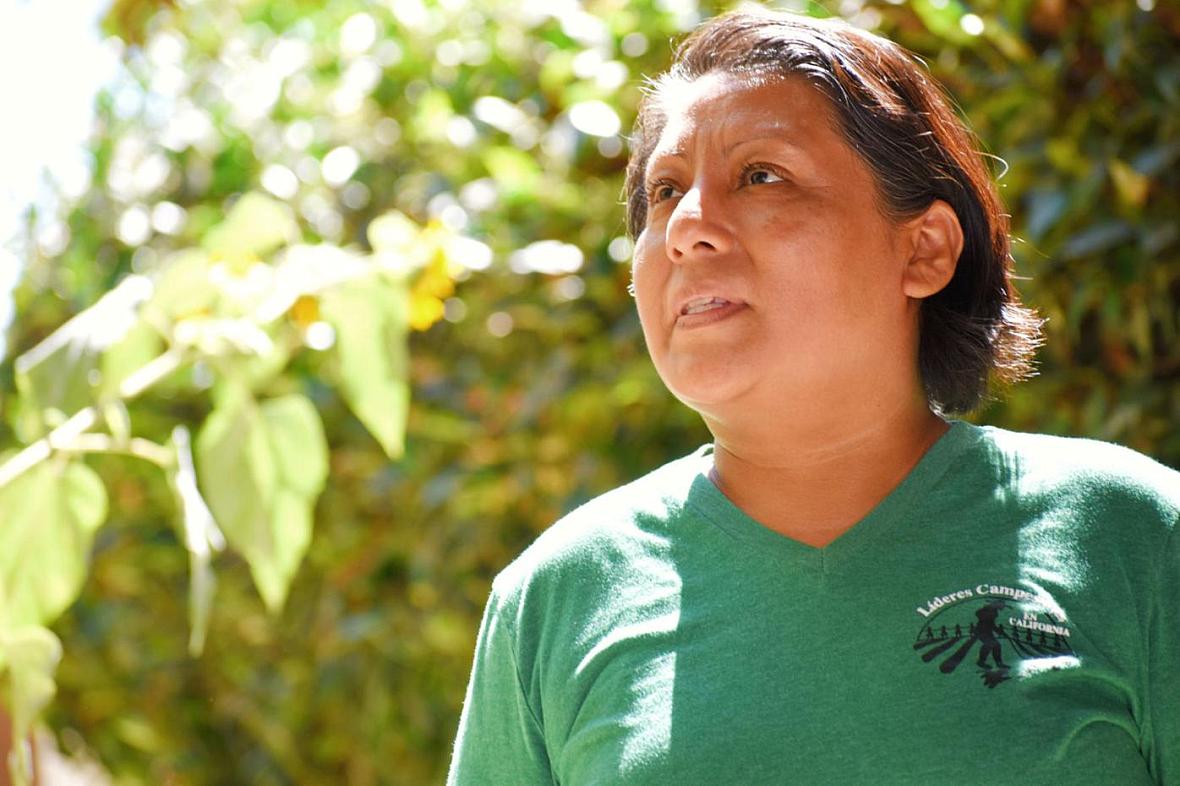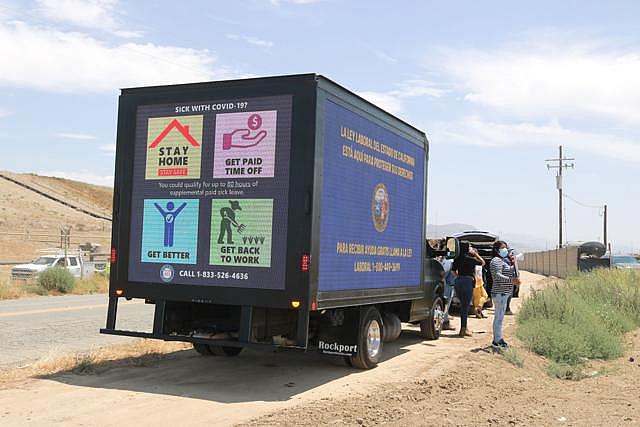Living with fear: COVID spread among Santa Maria's frontline workers fueled by crowded homes, trust gaps
This is the third of four stories in the weeklong series "COVID Hot Spot: an at-risk city" produced by Laura Place for the Center for Health Journalism's 2021 California Fellowship.
Her other stories:
Part 1: Left behind: Why Santa Maria became the epicenter for COVID-19 in Santa Barbara County
Part 2: Lost in translation: Language gaps hinder critical COVID-19 outreach in Santa Maria
Part 4: Learning lessons: Community seeks path to health equity as COVID retains grip on Santa Maria

Randy De La Pena
Santa Maria agriculture manager Daniel Chavez faced the challenge of quarantining nearly a dozen migrant farmworkers he had contracted through the H-2A program during a COVID-19 outbreak in late July.
Eleven of the 13 workers from Mac Ag tested positive for the virus while living between two single-family homes in Santa Maria.
“There was a concern of how not to let it spread. I didn’t want it to be overcrowded," Chavez said, describing how he separated the workers that tested negative into a bedroom with an attached restroom in each of the houses over their quarantine period. "It was definitely a wakeup call."
The story of Mac Ag’s outbreak is not unique, with crowded homes creating the perfect environment for COVID-19 cases to spread like wildfire in Santa Maria, an epicenter for the virus in Santa Barbara County.
Advocates and residents say that for essential workers living in cramped quarters, two of the most basic tenets of COVID prevention — social distancing and staying home from work when sick — were nearly impossible. Since the start of the pandemic, the Santa Barbara County Public Health Department has reported 39 COVID-19 outbreaks in the agricultural business sector, although the exact number related to employee housing is unknown.
In the same time frame, the department confirmed 2,143 COVID-19 cases among workers in the agricultural sector, making it one of the top four occupations in the county with the highest COVID-19 spread.
We are working with our partners to ensure that these workers understand that they do have rights, and to help them understand what it means to actually exercise those rights.— Lilia García-Brower, California labor commissioner
The exact number of cases in the sector is likely much higher — as of March, only 56% of residents who tested positive could be reached for an interview to confirm their occupation, according to the Santa Barbara County Public Health Department's most recent quarterly report.
In the case of Mac Ag, the majority of the workers had few symptoms, with the exception of one man who was treated in the hospital but returned shortly after, Chavez said. Following their recovery period, the workers who had not received the vaccine all agreed to get it.
Spreading the word about paid sick leave
Andrea Cabrera Hubbard, an organizer with women-led farmworker network Lideres Campesinas, can be found at various locations and events in and around Santa Maria where she informs particularly low-income residents and agricultural workers about the importance of COVID-19 vaccines, provides masks, and connects them to services and resources.
In the summer of 2021, Hubbard said one of the main points of outreach was supplemental paid sick leave — a right extended to any California employee at a business with 26 or more employees.
According to the California Department of Industrial Relations, the law affords qualifying full-time employees unable to work from home with 80 hours, or two weeks, of supplemental paid time for COVID-19 illness or quarantine through Sept. 30 and retroactive to Jan. 1.
However, many of the workers she spoke to, particularly agricultural workers, said that information was news to them.
“I think 90% of the people we talk to about the sick time, they say, ‘They don’t tell me nothing about it’,” Hubbard said.
According to the Phase One Report of the state's COVID-19 Farmworker Study — an ongoing survey led by community-based organizations, researchers and advocates into how farmworkers have protected themselves during the COVID-19 pandemic — Indigenous workers in agriculture are nearly twice as likely to report they lack sick leave than non-Indigenous workers, at a rate of 23.4% versus 12.8%.
The California Strawberry Commission, in addition to the Grower Shipper Association of Santa Barbara and San Luis Obispo Counties, worked throughout the pandemic to inform agricultural employers about worker safety requirements and in 2021, help with vaccination efforts.
"During the pandemic with all the changing information in the early weeks, it was really hard to keep up with all the info," said Chris Christian, California Strawberry Commission senior vice president. "The biggest challenge was to get materials and signage printed and getting them out to the farms."
A local labor rights car caravan, stopped on July 28 near a field on Foxen Canyon Road, is led by an LED billboard truck, with screens displaying contact information for state labor agencies and information about workers' rights. Laura Place, Staff
In certain counties like Santa Barbara with large agricultural sectors, the commission provided extra resources such as vaccine support and on-the-ground interaction with growers. A director of grower education from the commission continues to be stationed in Santa Maria to inform employers about safety measures.
"In Santa Barbara County, we were directly involved working with different agriculture associations and the Public Health Department. We were directly involved with getting 5,000 people vaccinated," Christian said. "We worked with grower-shippers, helped with providing translators to growers to get people signed up for vaccines, and then helped with translation at the vaccination sites."
While state and regional agriculture agencies took a largely top-down approach to sharing information with growers, advocates and state labor officials did the work of meeting workers in their neighborhoods, at shopping centers and at their worksites to ensure they understood their rights.
During a farmworker rights caravan through Santa Maria and Guadalupe in late July, representatives from the Department of Industrial Relations, Cal/OSHA, the Agricultural Labor Relations Board and the Employment Development Department joined with local advocates to spread the word about rights afforded to farmworkers during the pandemic, such as shaded areas, breaks, water and sanitation stations at worksites.
"We are working with our partners to ensure that these workers understand that they do have rights, and to help them understand what it means to actually exercise those rights," California Labor Commissioner Lilia García-Brower said during the caravan.
Lideres Campesinas, along with organizations like United Farm Workers, also made a habit of giving out masks to workers in the fields, or to employers when they were restricted from entering the worksites. On a couple of occasions, after dropping off masks at worksites, Hubbard said she found out that the employers were selling the masks to workers rather than providing them cost-free.
“That’s why we spread the word,” Hubbard said, referencing not only spreading information about workers' rights but correcting misinformation that may keep workers from accessing services. "We go to apartments, to motor homes, to the stores."
A historic distrust
Even with the availability of resources for quarantine, testing and eventually vaccines for agricultural workers, a strong distrust of government services kept many individuals from utilizing them.
Anahi Santos, an organizer with Central Coast Alliance United for a Sustainable Economy (CAUSE), manages a team of promotoras — health educators — who interact with residents in the immigrant community who are afraid to take advantage of government programs or even basic COVID-19 medical services due to fear of the "public charge" rule.
The rule that allowed authorities to deny green cards to immigrants who use food stamps or other public benefits was struck down by courts earlier this year, but advocates say distrust in public benefit programs remains widespread.
"It was something that a lot of people were misinformed about," Santos said, noting that many residents still believe they could face consequences for accessing basic services.
Fears around deportation or rejection of residency applications also have become more pronounced in the past two decades with the formation and increased presence of Immigration and Customs Enforcement.
In Santa Maria, the 2015 arrival of an ICE transfer facility relocated from Lompoc contributed to a sense of fear among the local immigrant population, with advocates warning city officials that the facility's presence would be detrimental to residents' sense of well-being.
More recently, those in the immigrant community have experienced increased anxiety about whether seeking any form of public aid could endanger their chances at citizenship. According to the COVID-19 Farmworker Study, the negative association has become a huge barrier to people accepting COVID-19 assistance.
"This stigma was exacerbated by the Trump administration’s 'public charge' ruling, which provoked fear in immigrant communities that their acceptance of any kind of help, even that which they were legally entitled to receive, would jeopardize their chances of legal residency or citizenship," said Phase Two of the report.
An example can be found in usage of the state-run Housing for the Harvest program, which provided free hotel rooms in which farmworkers could quarantine if they did not have a place in their home to do so.
In Santa Maria, 24 people utilized the program between September 2020 and January 2021. Statewide, 112 reservations were made throughout the 13 participating counties, including Santa Barbara County, as of February.
Low usage could partially be attributed to farmworkers' reticence about seeking public aid, as well as being far from their families, the COVID-19 Farmworker Study found in speaking to workers throughout the state.
"Many farmworkers who were not single or H-2A guest workers hesitated to participate in Housing for the Harvest because participating hotels were far from their homes in rural communities," the report states. "Fear of family separation and distrust of state-sponsored programs, again, due to 'public charge' concerns, were reasons few farmworkers participated."
Yeimi Arias, Health and Human Services grant manager for Family Service Agency, said that as their agency conducted contact tracing and outreach to residents in Santa Maria, many were hesitant to offer personal information or take advantage of services related to food, housing or medical and mental health treatment.
As much as digital and language gaps hindered communication about COVID-19 in immigrant and farmworker populations, fear of immigration enforcement proved an equally strong barrier.
"Lots of phones weren’t working, email was not necessarily an option with that population, and then it was just trust, right? They were concerned about their status here, if we were going to put them on 'the radar'," Arias said.
Editor's note
This is the third of four stories in the weeklong series "COVID Hot Spot: an at-risk city" produced in partnership with the Center for Health Journalism, investigating the risk factors and decisions that allowed COVID-19 to spread disproportionately throughout Santa Maria over the past year and a half.
[This article was originally published by Santa Maria Times.]
